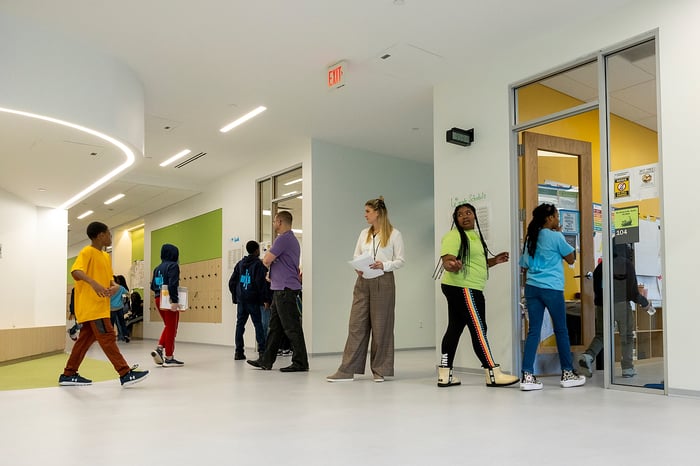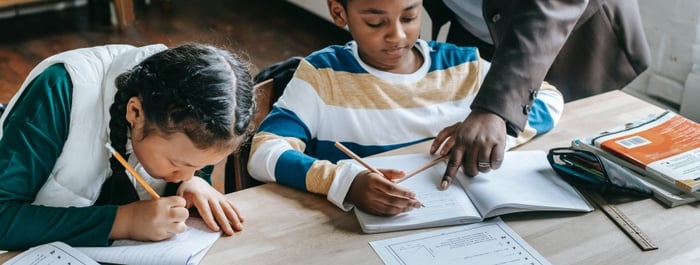Ten Ideas for Keeping Students with Diverse Learning Needs Engaged At Home
Tools • 12 min read • Mar 26, 2020 3:20:49 PM • Written by: Sarah Sandelius

The world has changed (and continues to change by the hour), but despite the uncertainty, our communities are showing tremendous resilience by rallying in support of each other, especially when it comes to educating our nation’s young people. Transitioning to remote instruction with little training and no time to plan is hard work, both for seasoned educators and for parents turned first-time homeschoolers. But it’s critical now to do what we can to provide consistency and structure for young people amidst other challenges.
To help educators support students with different learning needs, including those with disabilities, via remote instruction and at-home learning, the following top 10 considerations can guide your planning. The examples provided are meant to further illustrate each point but will need to be adjusted depending on grade level, interest, at-home resources, student needs, and other factors.
Furthermore, we have provided guidance and tips on how families and caregivers (who are now effectively “co-teachers”) can provide essential support for their children’s at-home learning. As parents, this information provides ideas tailored to each child’s strengths and needs. As teachers and administrators, this information should shape how you communicate with families. Greater collaboration between educators and families can more successfully facilitate remote learning practices and can buffer the stress and potential anxiety experienced by students in this new learning structure and environment.
Click here to download a copy of this resource.
10. Know Your Students’ Access to Technology.
| What Teachers Can Do: | What Parents Can Do: |
| IDEAS FOR PLANNING Different tools have different functionalities depending on whether they’re being accessed on laptops, tablets, phones, etc. Additionally, many families have access to little or no technology or have to share the technology they have. |
IDEAS FOR PLANNING |
|
PUTTING IT INTO ACTION |
PUTTING IT INTO ACTION Families may want to keep track of each child’s use of technology during the day in order to moderate potential challenges that arise with too much screen time. |
9. Provide Low- or No-tech Alternatives.
| What Teachers Can Do: | What Families Can Do: |
| IDEAS FOR PLANNING If possible, each assignment should have a modified option for students who do not have access to the necessary technology. |
IDEAS FOR PLANNING |
| PUTTING IT INTO ACTION Consider providing phone-in options for lessons or using common household items for learning activities when it is appropriate. For example, ask students to complete puzzles or use dice to create their own math games. Depending on your community, students could volunteer to swap resources by leaving them on each others’ doorsteps. |
PUTTING IT INTO ACTION Take inventory of your games, cards, and puzzles. You may not realize you have tools at home that you can leverage. Monopoly teaches math and card games teach strategic thinking. Cooking (especially with a recipe) can teach math and science. Embedding small reading tasks into daily activities or asking comprehension questions can also build literacy skills. |
8. Provide Instructions Multiple Times and in Multiple Modalities.
| What Teachers Can Do: | What Families Can Do: |
| IDEAS FOR PLANNING Many students with behavioral needs or other disabilities benefit from receiving instructions multiple times and in different formats. |
IDEAS FOR PLANNING |
| PUTTING IT INTO ACTION Consider chunking assignments and asking students to hand in smaller tasks in sequence in order to scaffold learning in ways that provide more access to students who need more structure to complete multi-step problems. It might also help to record short videos modeling assignments so students can watch and rewatch tasks as needed. |
PUTTING IT INTO ACTION Families can support the learning process by creating “to-do” lists as well as visual schedules for students who may need additional scaffolds and support. Engage your child in creating the schedules – you might be surprised what they come up with! |
7. Deliver Content in Different Ways.
| What Teachers Can Do: | What Families Can Do: |
| IDEAS FOR PLANNING Varying how your students interact and learn is an essential piece of making instruction inclusive. |
IDEAS FOR PLANNING |
| PUTTING IT INTO ACTION On a given day, try switching between video instruction/content, worksheets, independent reading, and learning through hands-on projects to maximize engagement and provide unique entry points for children with diverse learning needs. |
PUTTING IT INTO ACTION Parents might want to try a virtual field trip to a historical building followed by creating diorama representations with legos, cardboard, or magazine cut-outs. Students can present what they’ve created to their teachers or to others in a photo or via web conference. |
6. Let Students Choose What to Work On.
| What Teachers Can Do: | What Families Can Do: |
| IDEAS FOR PLANNING Allowing students opportunities to select topics to study or methods for demonstrating knowledge can help students with disabilities play into their strengths and feel more confident. |
IDEAS FOR PLANNING Leverage loved ones or other community members as a part of the learning process. Distance learning allows people who are not close by to engage in your child’s education in ways that traditional classroom learning does not. |
| PUTTING IT INTO ACTION For example, for a lesson on building comprehension, try asking students to read or listen to a book about a topic of interest and journal or draw daily about their reflections. |
PUTTING IT INTO ACTION |
5. Know Your Students’ Strengths and Teach to Them.
| What Teachers Can Do: | What Families Can Do: |
|
IDEAS FOR PLANNING |
IDEAS FOR PLANNING You know your child. Take this opportunity to further communicate with teachers about your child’s strengths and interests. |
| PUTTING IT INTO ACTION For example, because many students with ADHD benefit from experiential learning, keep them engaged by putting together a virtual scavenger hunt where students have to use the internet to find answers and resources on topics of interest. |
PUTTING IT INTO ACTION |
4. Establish Routines and Communicate Regularly.
| What Teachers Can Do: | What Families Can Do: |
| IDEAS FOR PLANNING Even if your school or district doesn’t require any specific outreach or communication, teachers who have regular and ongoing contact with their students and families will help provide much-needed support and continuity. |
IDEAS FOR PLANNING While positive and predictable structures are important for children generally, they are particularly important when working with students with emotional disabilities or students with autism. Even if they are minimal, regular communication and consistency of routine can go a long way to helping children through these challenging times. |
|
PUTTING IT INTO ACTION |
PUTTING IT INTO ACTION Connect with your child’s teachers to find out how consistency and routines can be reinforced at home. |
3. Build In Downtime.
| What Teachers Can Do: | What Families Can Do: |
| IDEAS FOR PLANNING For some students with disabilities, such as students with autism, home instruction could be a needed respite from the sensory inputs of everyday life. |
IDEAS FOR PLANNING While families may be worried about learning loss in what could be a long hiatus, it’s important to remember that taking breaks promotes more focus in the long run. |
| PUTTING IT INTO ACTION Encouraging partner work over email or phone, either semi-structured or even unstructured, provides students with opportunities for communication and social skills development in a lower-stakes environment. |
PUTTING IT INTO ACTION Make sure you provide opportunities for unstructured down-time to keep spirits high. Children can do this by playing at home with their siblings or riding their bikes outside. |
2. Practice Self-Care.
| What Teachers Can Do: | What Families Can Do: |
| IDEAS FOR PLANNING Be kind to your students and to yourself. Many of us are juggling several hats right now, teaching our students, teaching our own children, getting resources to loved ones, and supporting families through this difficult time. |
IDEAS FOR PLANNING Be kind to your child and yourself! Remote learning doesn’t have to be perfect and making your children feel physically and emotionally supported is of most importance. |
| PUTTING IT INTO ACTION Some educators are creating wellness check-ins for their students through a Google doc, form, or other platform and asking them to let you know how they are doing. Consider doing something similar for your peers or colleagues to support each other. |
PUTTING IT INTO ACTION Try to make time for your child to participate in his/her/their teachers’ virtual office hours or organize virtual happy hours for children and adults to check in with one another. |
1. Keep Learning.
| What Teachers Can Do: | What Families Can Do: |
| IDEAS FOR PLANNING Don’t forget to routinely reflect on your practice. Asking what went well, what could have been better, and what needs to happen next time after each lesson can go a long way to getting you up to speed quickly with remote or home instruction. |
IDEAS FOR PLANNING Recognize that as a first-time “teacher” you may have a steep learning curve, especially if you are juggling your own full-time job. |
| PUTTING IT INTO ACTION If you haven’t already, dig into the materials from CAST about Universal Design for Learning (UDL) which is a helpful framework for planning instruction for learners with diverse needs and has many technology-based solutions that can be used remotely. |
PUTTING IT INTO ACTION See if your child’s teachers can give you some basic training so you can be more supportive in the learning process. Share your expectations for learning with both teachers and your child. |
At ABC, we created an open Slack community as a forum for teachers and parents to talk about how they’re supporting students with disabilities through remote learning. We’ve been intentional about offering a space away from the pressures of social media and believe we can build a virtual community of dialogue, honesty, compassion, and support if we all commit to engaging and sharing what we can.
Try these strategies and tell us what resonated. Offer your thoughts on what special education should look like via remote instruction. Share your wins. We are in this together.
If you’re looking for additional support as you transition to remote instruction or as you think about transitioning back to school, contact us at info@theabilitychallenge.org, follow us on social media (Twitter, Facebook, LinkedIn), and subscribe to our newsletter at www.theabilitychallenge.org.
Ready to Make an Impact For Your Most Diverse Learners?
Sarah Sandelius
Our Latest
Related Articles

February 15, 2024 | Administrators
Three Special Education Investment Recommendations on a Limited Budget
Learn how to optimize your budget and improve special education in your school. Discover three strat...

October 14, 2022 | Tools
Supporting Your Teachers to Design Quality Special Education Instruction
Unlock the power of SDI (Specially Designed Instruction) under IDEA. Explore effective instructional...

May 13, 2024 | Administrators
Intervention: Have We Gone Too Far?
Is your school overreliant on intervention? Learn how to support diverse learners, including student...
